If you’ve been dreaming of bringing a touch of the orchard into your living space, growing fruit trees indoors isn’t as far-fetched as it sounds. You’ll discover that many fruit trees adapt surprisingly well to indoor environments, especially when you select compact varieties bred specifically for container growing. From the sweet Meyer lemon to the exotic guava, your options extend far beyond the typical houseplant – and the rewards are genuinely tasty.
Contents
1. Meyer Lemon Tree
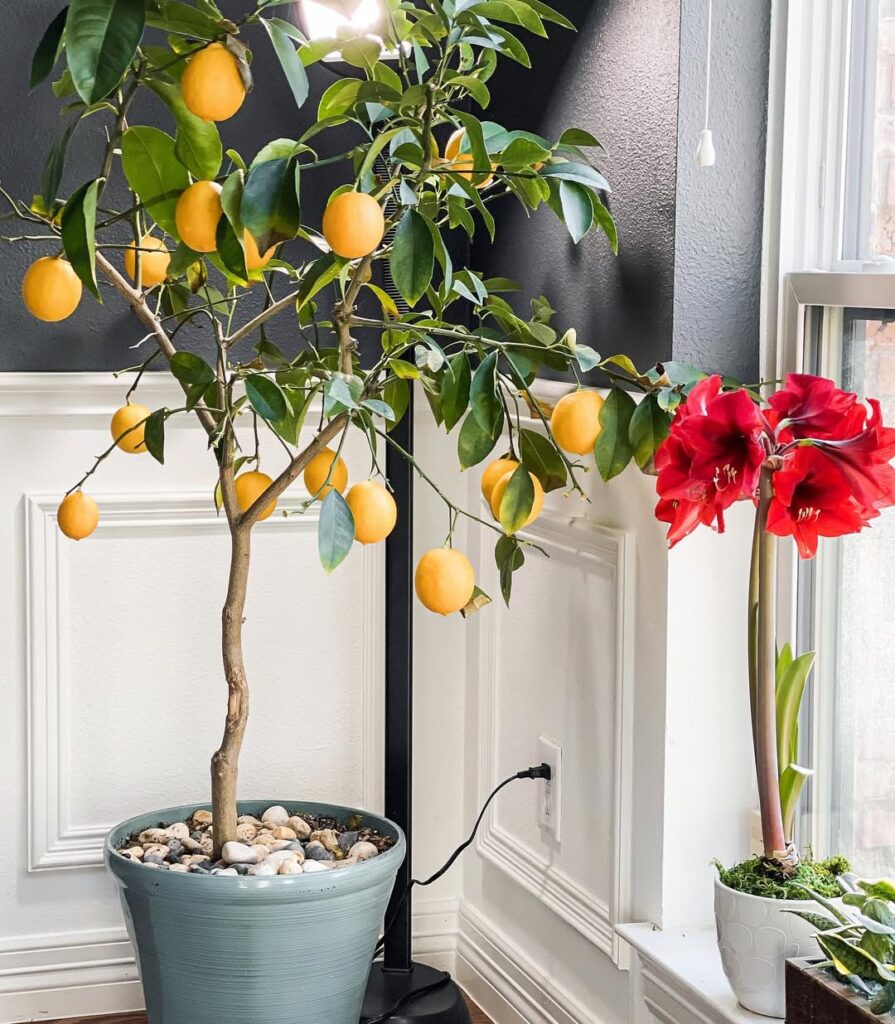
Meyer lemon trees are popular dwarf citrus varieties well-suited for indoor growing, typically reaching heights of 6-10 feet when grown in containers. These trees produce sweeter, less acidic fruits than standard lemons and can bear fruit year-round, with peak harvests occurring in winter months. Indoor Meyer lemon trees are self-pollinating and can begin producing fruit within 2-3 years of planting, making them an attractive choice for indoor gardeners seeking both ornamental value and edible rewards.
- Light: Requires 8-12 hours of direct sunlight daily; south-facing windows are ideal; supplement with grow lights if needed
- Water: Keep soil consistently moist but not waterlogged; water when top 1-2 inches of soil feels dry
- Soil: Well-draining, slightly acidic citrus mix with pH 5.5-6.5
- Humidity: Maintain 50% or higher humidity; use pebble trays or humidifiers
- Temperature: Prefers 65-70°F during day, can tolerate down to 55°F at night
- Container: Use pot with adequate drainage holes; size up gradually as tree grows
- Fertilizer: Apply citrus-specific fertilizer every 6-8 weeks during growing season
2. Fig Tree

The indoor fig tree is a popular choice for indoor fruit cultivation due to its attractive broad leaves and potential to produce sweet, edible figs year-round in the right conditions. While outdoor fig trees can grow quite large, indoor varieties like the Fiddle Leaf Fig (Ficus lyrata) and Brown Turkey Fig (Ficus carica) can be maintained at a manageable size through regular pruning. These adaptable plants can thrive indoors when their basic needs are met, making them an excellent choice for home gardeners looking to grow edible fruits inside.
- Light: Requires 6-8 hours of bright, indirect sunlight daily; best placed near a south-facing window
- Water: Water thoroughly when top 1-2 inches of soil feels dry; reduce watering in winter
- Soil: Well-draining potting mix rich in organic matter; pH between 6.0-6.5
- Temperature: Prefers 65-75°F (18-24°C); can tolerate brief periods outside this range
- Humidity: Moderate humidity (40-50%); benefits from occasional misting
- Fertilizer: Feed monthly during growing season with balanced, water-soluble fertilizer
- Container: Large pot with adequate drainage holes; repot every 2-3 years
- Air Circulation: Good air flow while avoiding cold drafts
3. Calamondin Orange Tree
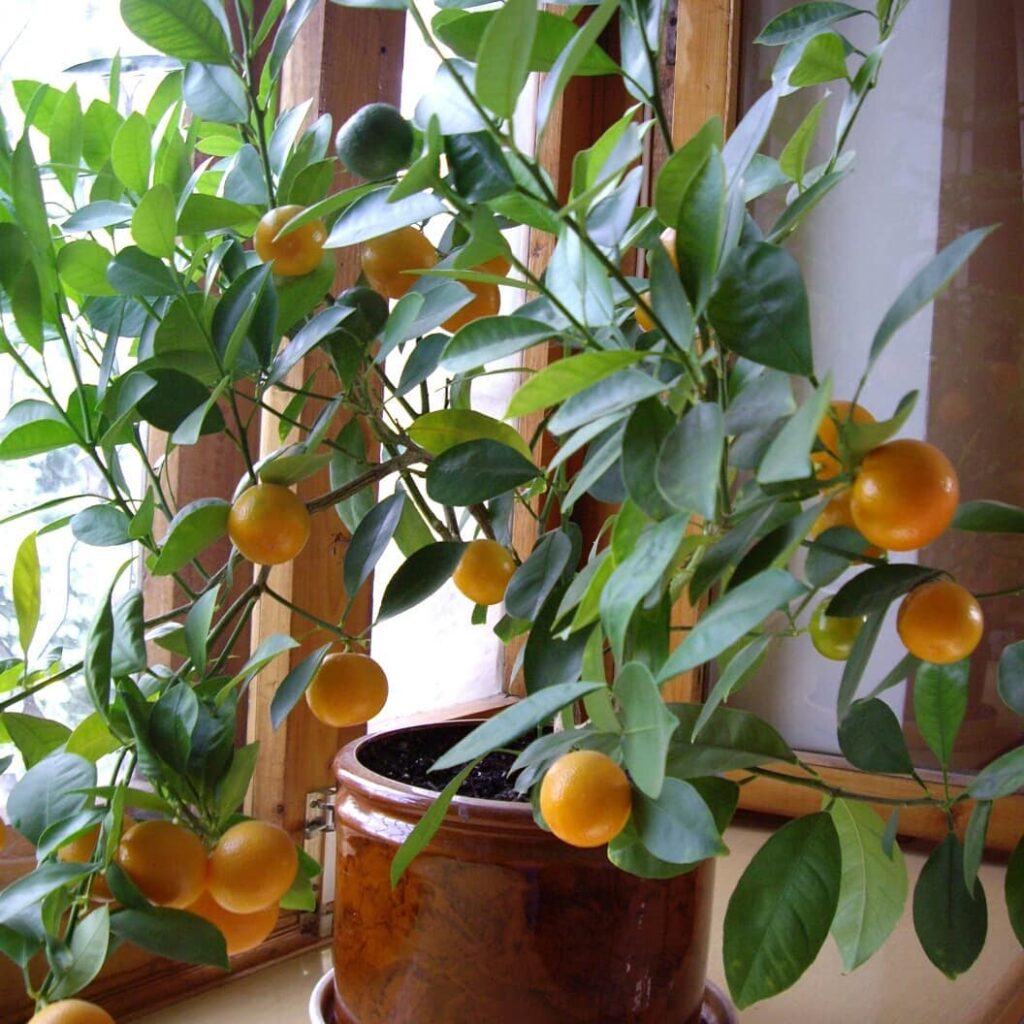
The Calamondin orange tree (Citrofortunella microcarpa) is a compact citrus hybrid that’s well-suited for indoor growing, typically reaching heights of 2-4 feet when container-grown. This evergreen plant produces small, tart oranges year-round that are about 1 inch in diameter, featuring thin, acidic flesh that’s commonly used in cooking and beverages. Its glossy dark green leaves and fragrant white blossoms make it an attractive houseplant, while its natural dwarf characteristics and tolerance for indoor conditions make it one of the easiest citrus varieties to grow inside.
- Light: Bright, direct sunlight for 6-8 hours daily; south-facing window ideal; supplemental grow lights beneficial in winter
- Water: Keep soil consistently moist but not waterlogged; water when top 1-2 inches of soil feels dry
- Humidity: 50% or higher; use humidity tray or mist regularly
- Temperature: 65-80°F (18-27°C); protect from cold drafts
- Soil: Well-draining citrus mix or potting soil with added perlite and sand
- Fertilizer: Balanced citrus fertilizer applied every 4-6 weeks during growing season
- Container: Pot with adequate drainage holes; repot every 2-3 years
4. Avocado Tree
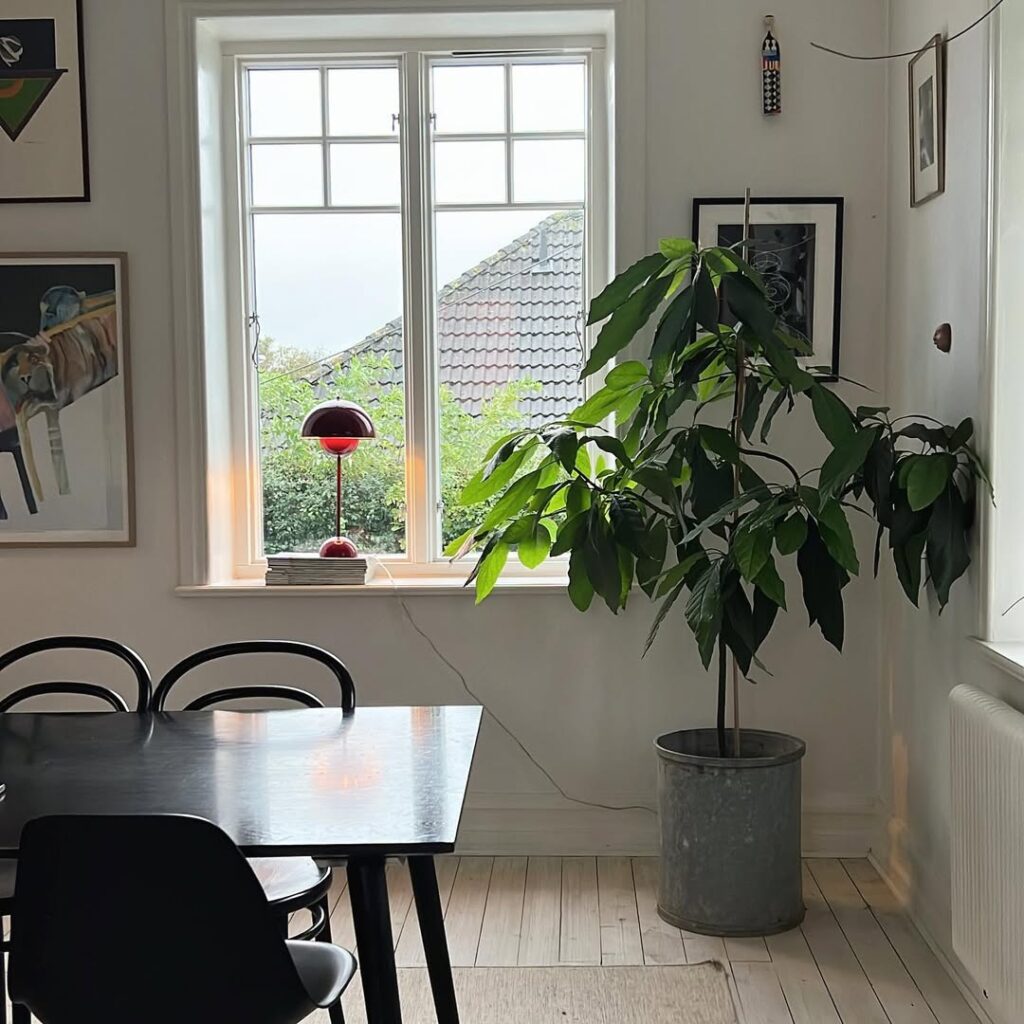
Growing an avocado tree indoors can be a rewarding project that starts from either a pit or a dwarf variety purchased from a nursery. Indoor avocado trees typically reach heights of 6-10 feet when properly maintained and can take 3-5 years before producing fruit, though some may never fruit indoors. While they make attractive houseplants with their glossy, dark green leaves and vertical growth habit, they require consistent care and ideal conditions to thrive in an indoor environment.
- Light: Bright, direct sunlight for 6-8 hours daily; south or west-facing window preferred
- Water: Keep soil consistently moist but not waterlogged; water when top 2 inches of soil feels dry
- Soil: Well-draining, slightly acidic potting mix with pH 6.0-6.5
- Humidity: 50% or higher; regular misting or humidity tray recommended
- Temperature: 60-85°F (15-29°C); protect from cold drafts
- Container: Large pot with adequate drainage holes; repot every 2-3 years
- Fertilizer: Balanced, water-soluble fertilizer every 2-3 months during growing season
- Pruning: Regular trimming to maintain size and shape; pinch new growth to encourage bushiness
5. Pomegranate Tree
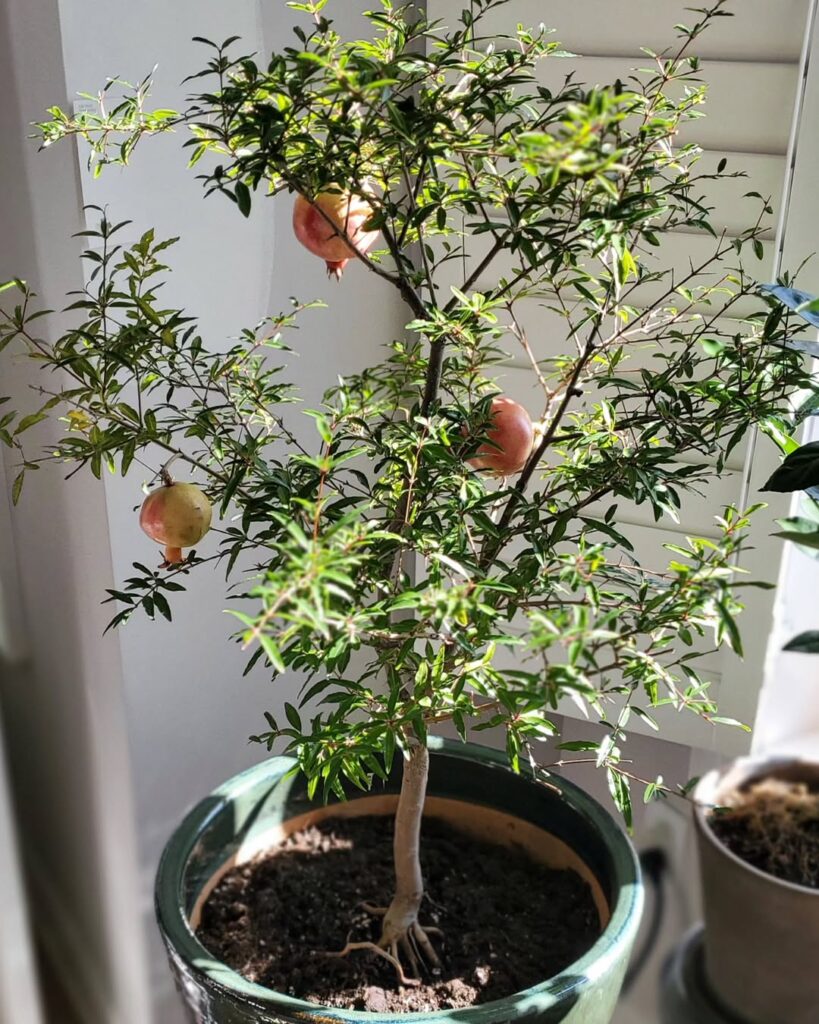
Indoor pomegranate trees are dwarf varieties that can be successfully grown as houseplants, typically reaching heights of 2-4 feet when container-grown. These compact fruit trees produce the same vibrant red flowers and distinctive red fruits as their outdoor counterparts, though yields are usually smaller. While they make attractive ornamental plants year-round, indoor pomegranates require specific conditions and regular maintenance to thrive and produce fruit.
- Light: Requires 6-8 hours of direct sunlight daily; place near south-facing windows or supplement with grow lights
- Temperature: Maintains best growth at 60-75°F (15-24°C)
- Humidity: Tolerates average household humidity but prefers 40-50%
- Soil: Well-draining potting mix with added perlite; pH 5.5-7.0
- Water: Keep soil consistently moist but not waterlogged; water when top inch of soil feels dry
- Container: Use pot with adequate drainage holes; minimum 15-gallon size for mature tree
- Fertilizer: Apply balanced, slow-release fertilizer every 3 months during growing season
- Pruning: Regular trimming to maintain shape and size; remove suckers and dead branches
6. Olive Tree

Indoor olive trees make excellent houseplants with their silvery-green leaves and compact growth habit when properly maintained. While they rarely produce fruit indoors, these Mediterranean natives add an elegant touch to any room and can thrive for many years as container plants when given the right care. Dwarf varieties like ‘Arbequina’ and ‘Little Ollie’ are particularly well-suited for indoor growing, typically reaching heights of 4-6 feet.
- Light: Requires 6-8 hours of direct sunlight daily; south-facing windows are ideal; supplement with grow lights if needed
- Water: Allow top 2 inches of soil to dry between waterings; water deeply but avoid waterlogged soil; reduce watering in winter
- Soil: Well-draining, slightly alkaline potting mix with added perlite and sand; pH 6.5-7.5
- Temperature: Prefers 65-80°F (18-27°C); can tolerate brief periods of cooler temperatures
- Humidity: Tolerates average indoor humidity; benefits from occasional misting
- Fertilizer: Feed with balanced, water-soluble fertilizer every 4-6 weeks during growing season
- Container: Use pot with adequate drainage holes; repot every 2-3 years
7. Banana Tree
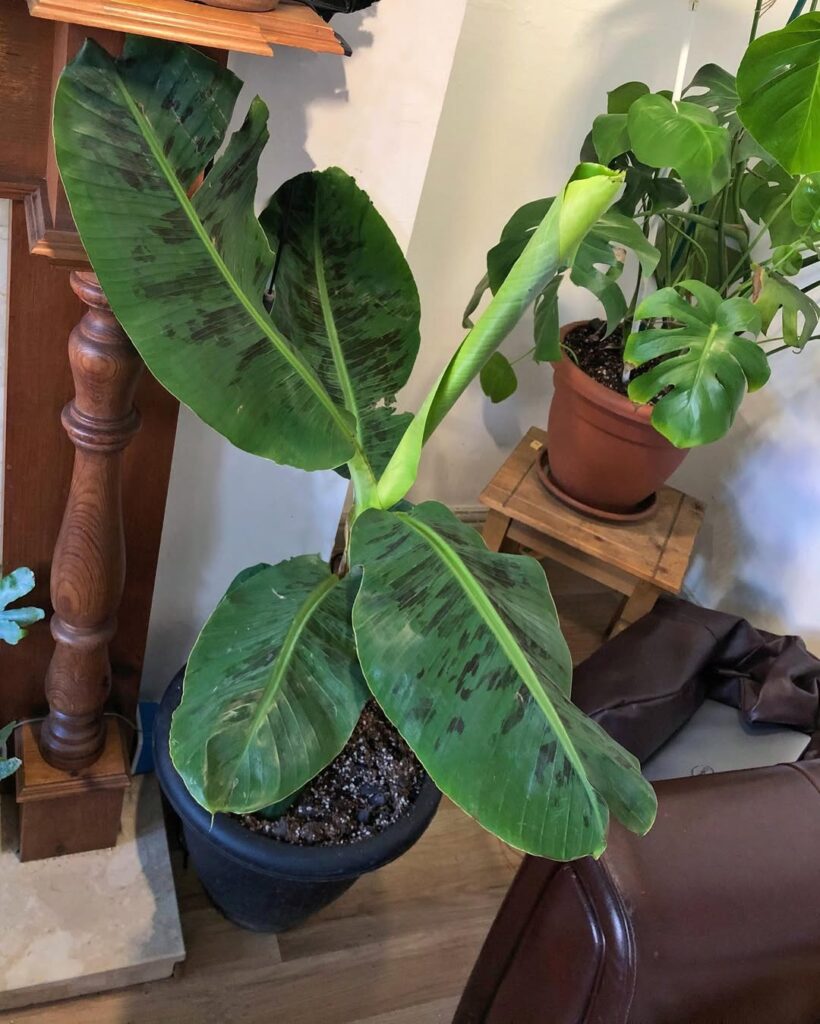
Growing banana trees indoors can be a rewarding experience, though most indoor varieties are dwarf cultivars that typically reach heights of 4-8 feet rather than their towering outdoor cousins. The Dwarf Cavendish and Super Dwarf Cavendish are popular indoor choices, prized for their large, tropical foliage and potential to produce edible fruit under ideal conditions. While indoor bananas rarely fruit in typical home environments, they make striking ornamental plants that add a dramatic, exotic touch to interior spaces.
- Light: Bright, direct sunlight for 6-8 hours daily; place near south-facing windows
- Temperature: 60-80°F (15-27°C); protect from cold drafts
- Humidity: High humidity (60% or higher); regular misting or use of humidity tray
- Soil: Rich, well-draining potting mix with high organic content; pH 5.5-6.5
- Water: Keep soil consistently moist but not waterlogged; water when top 1-2 inches of soil feels dry
- Fertilizer: Feed monthly during growing season with balanced, water-soluble fertilizer
- Container: Large pot with drainage holes; repot annually as plant grows
- Space: Allow 3-4 feet of space for spread of leaves
9. Key Lime Tree
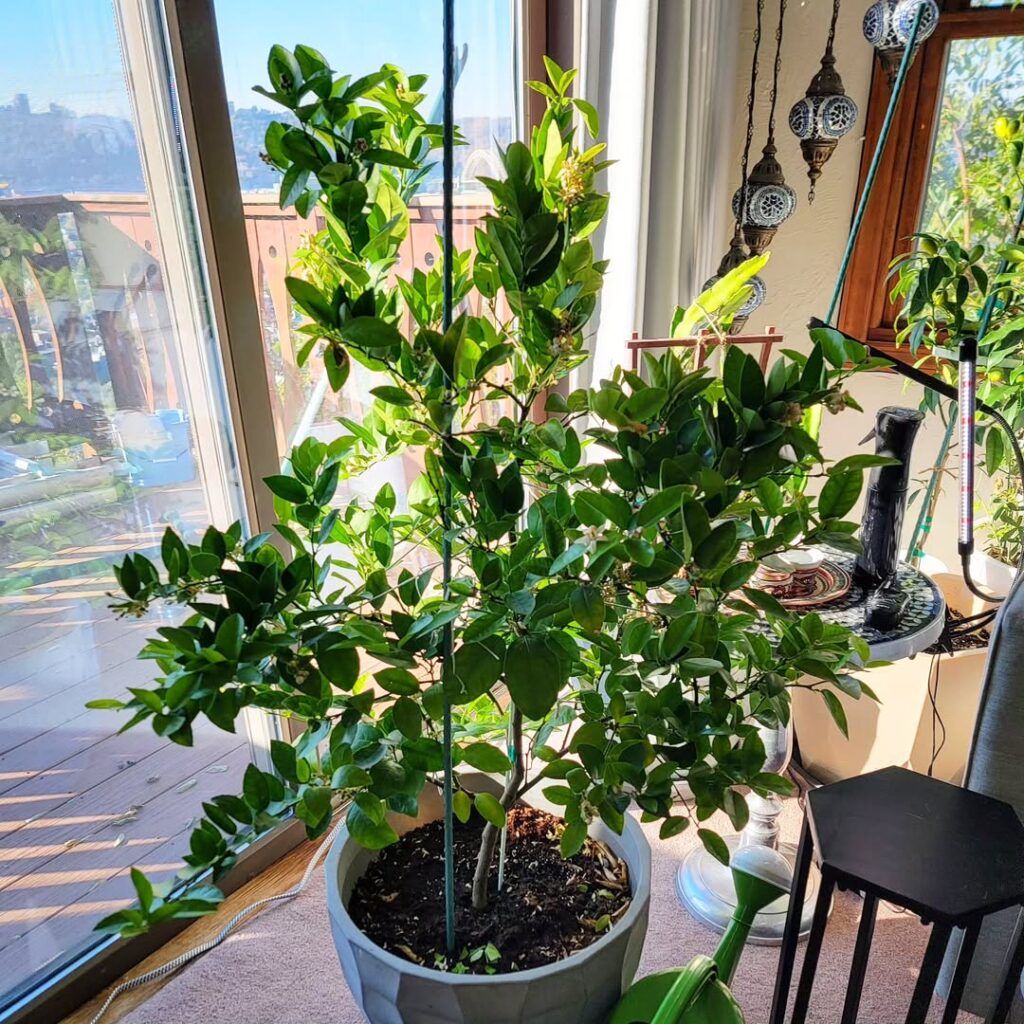
Key lime trees can thrive as indoor plants when given proper care, typically reaching heights of 6-8 feet in containers. These compact citrus trees produce small, aromatic limes year-round and feature glossy dark green leaves with fragrant white blossoms. Indoor key lime trees not only serve as attractive houseplants but also provide fresh fruit for cooking and garnishing, making them a practical choice for indoor fruit cultivation.
- Light: Requires 6-8 hours of direct sunlight daily; place near south-facing window; supplement with grow lights if needed
- Temperature: Maintains best growth at 65-75°F; protect from cold drafts
- Humidity: Prefers 50% or higher; use humidity tray or mist regularly
- Soil: Well-draining citrus potting mix with pH 6.0-6.5
- Water: Keep soil consistently moist but not waterlogged; water when top 2 inches of soil feels dry
- Container: Use pot with adequate drainage holes; size up gradually as tree grows
- Fertilizer: Apply citrus-specific fertilizer every 6-8 weeks during growing season
- Pruning: Trim regularly to maintain shape and encourage bushy growth
- Air Circulation: Maintain good airflow to prevent pest issues
10. Dwarf Apricot Tree
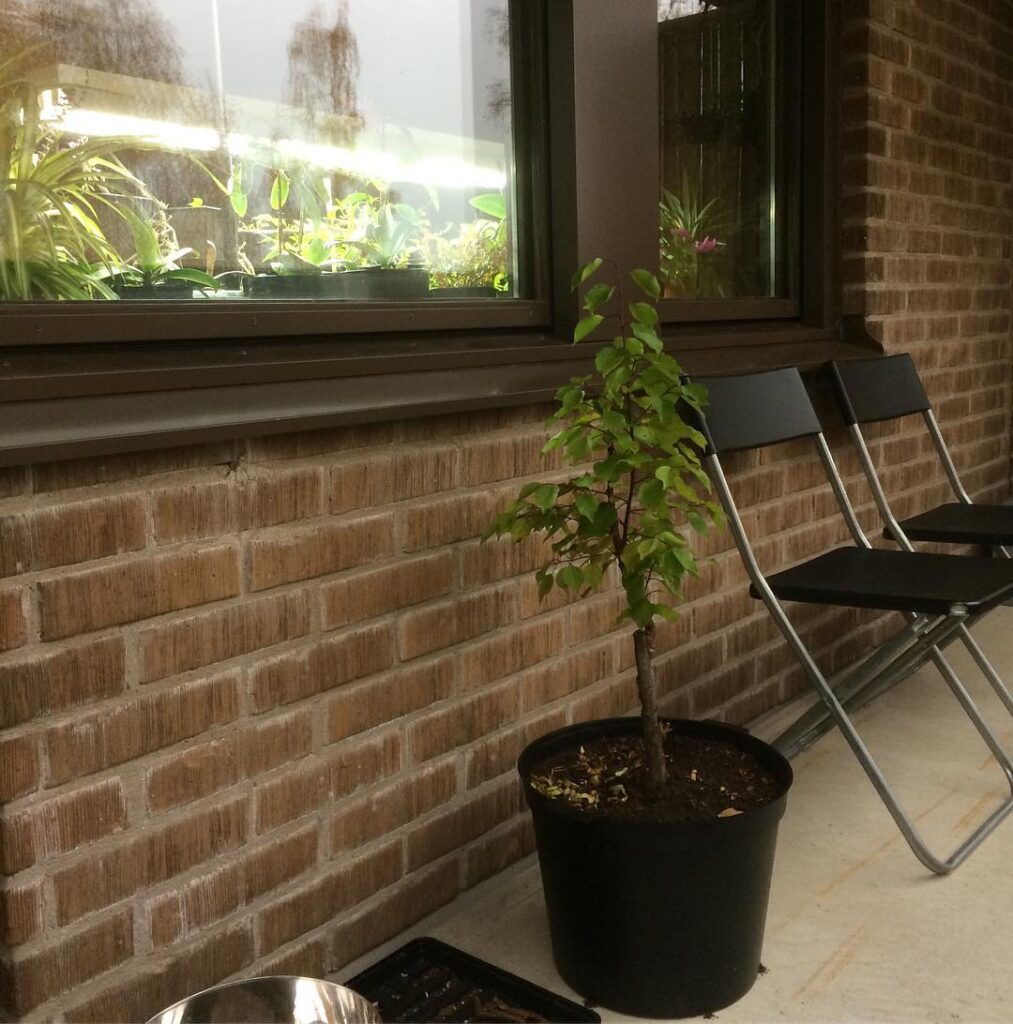
Indoor dwarf apricot trees are compact varieties specifically bred for container growing, typically reaching heights of 4-6 feet when mature. These miniature fruit trees can produce full-sized apricots and make excellent indoor specimens when given proper care. While they may not yield as abundantly as their outdoor counterparts, they can provide fresh apricots and attractive spring blossoms while serving as decorative elements in sunny indoor spaces.
- Light: Requires 6-8 hours of direct sunlight daily; place near south-facing windows or supplement with grow lights
- Temperature: Maintains best growth at 60-75°F (15-24°C); needs 2-3 months of temperatures below 45°F for fruit production
- Water: Keep soil consistently moist but not waterlogged; water when top inch of soil feels dry
- Soil: Well-draining potting mix rich in organic matter with pH between 6.0-6.5
- Humidity: Prefers moderate humidity around 40-50%
- Container: Use a 15-20 gallon pot with drainage holes
- Fertilizer: Apply balanced, slow-release fertilizer in spring and summer months
- Pruning: Regular pruning to maintain shape and size, especially in winter dormancy
11. Kumquat Tree
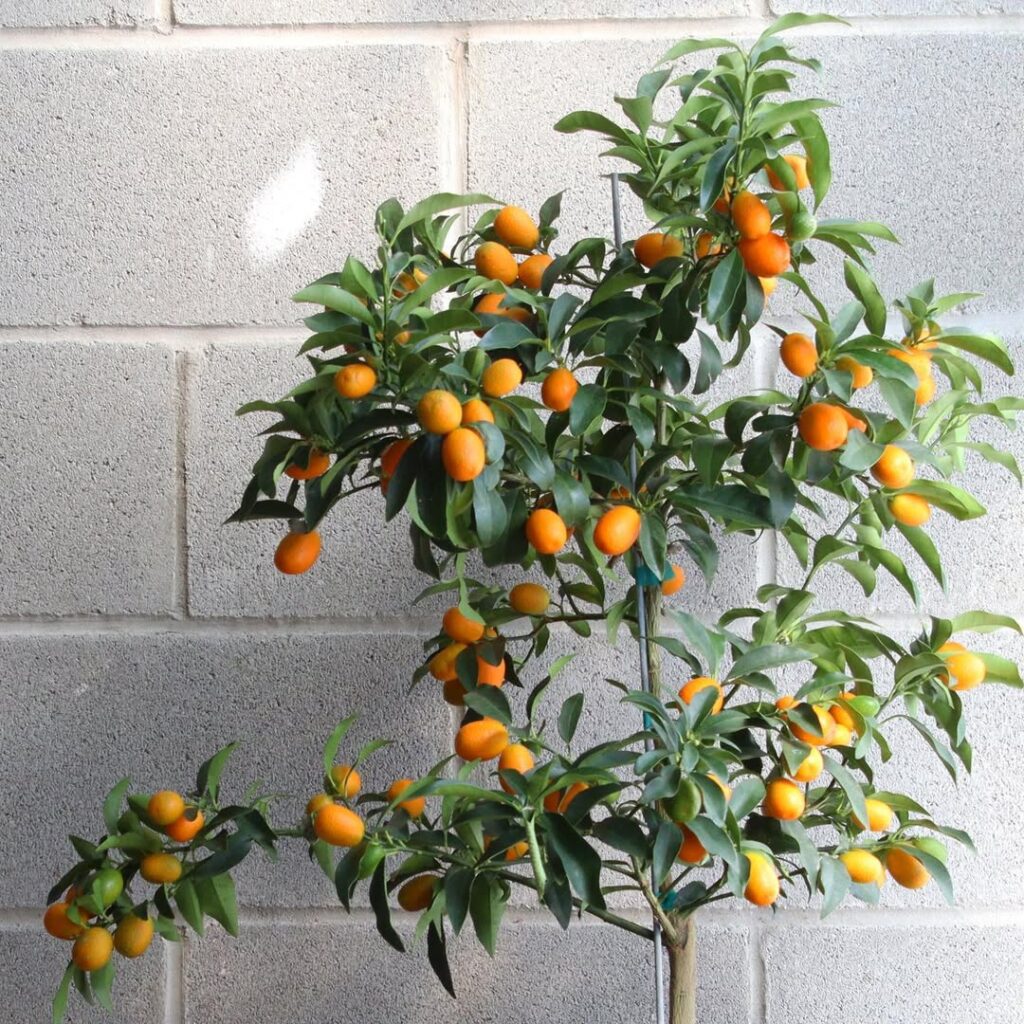
The indoor kumquat tree is a compact citrus variety that adapts well to container growing, making it an excellent choice for indoor cultivation. These small trees typically reach heights of 4-6 feet when grown indoors and produce tiny, oval-shaped citrus fruits that can be eaten whole, including the sweet rind and tart flesh. Kumquats flower in late winter to early spring, with fruits developing and ripening over several months, providing both ornamental value and edible harvests.
- Light: Requires 6-8 hours of direct sunlight daily; south or southwest-facing window is ideal
- Water: Keep soil consistently moist but not waterlogged; water when top 1-2 inches of soil feels dry
- Humidity: Prefers 50% or higher humidity; use humidity tray or mist regularly
- Temperature: Maintains best growth between 65-70°F (18-21°C)
- Soil: Well-draining citrus potting mix with pH 6.0-7.0
- Container: Use pot with adequate drainage holes; size up gradually as tree grows
- Fertilizer: Apply balanced citrus fertilizer every 4-6 weeks during growing season
- Pruning: Light pruning in early spring to maintain shape and remove dead branches
12. Dwarf Peach Tree
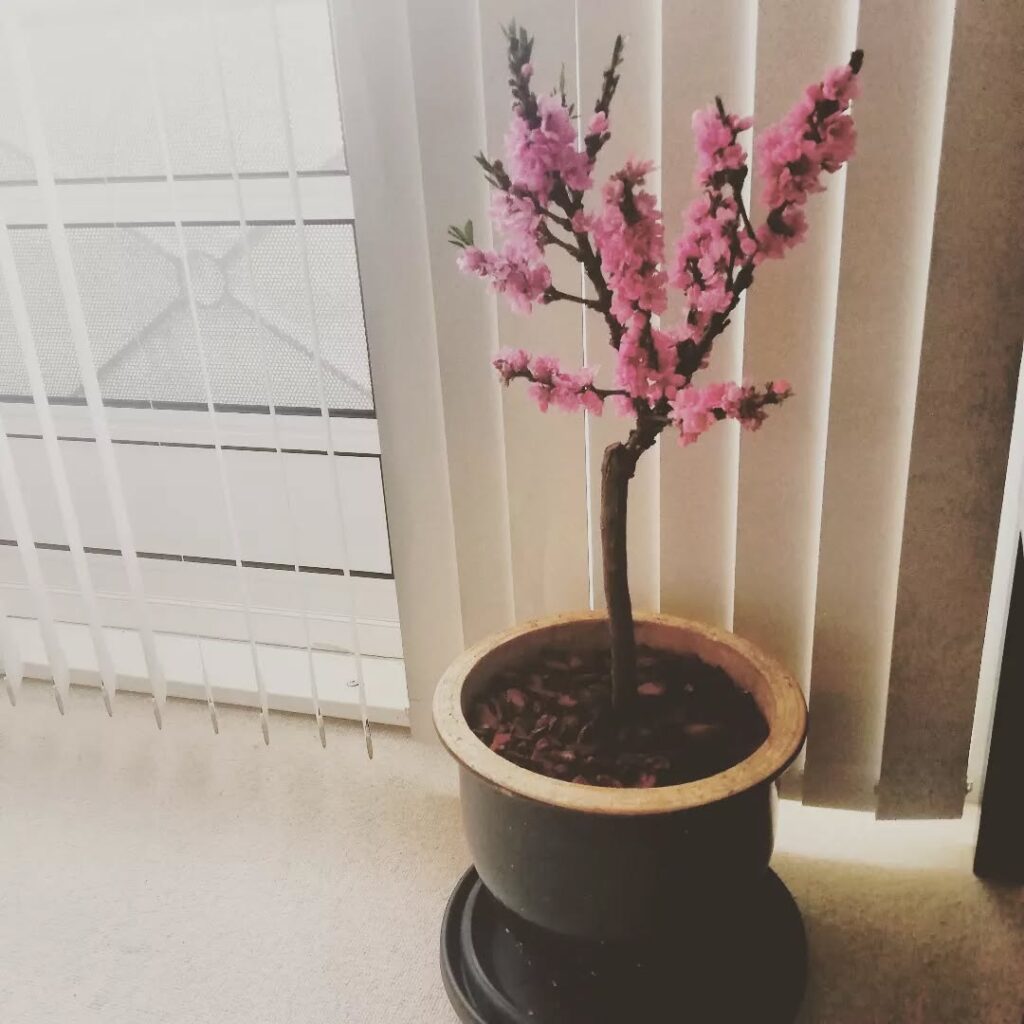
Indoor dwarf peach trees are compact varieties specifically bred for container growing, typically reaching heights of 3-6 feet. These miniature fruit trees can produce full-sized, sweet peaches when properly maintained indoors, making them an excellent choice for gardeners with limited outdoor space. While they require more attention than some other indoor fruit trees, their beautiful spring blossoms and summer fruit make them rewarding additions to any indoor garden.
- Light: Requires 6-8 hours of direct sunlight daily; place near south-facing window or supplement with grow lights
- Temperature: Maintains best growth at 65-75°F (18-24°C); needs winter chill period of 35-45°F
- Soil: Well-draining potting mix rich in organic matter with pH between 6.0-6.5
- Water: Keep soil consistently moist but not waterlogged; water when top inch of soil feels dry
- Humidity: Moderate humidity (40-50%); mist leaves regularly during growing season
- Container: 15-20 gallon pot with adequate drainage holes
- Fertilizer: Apply balanced, slow-release fertilizer in spring and summer months
- Pruning: Regular pruning needed to maintain shape and encourage fruit production
13. Guava Tree
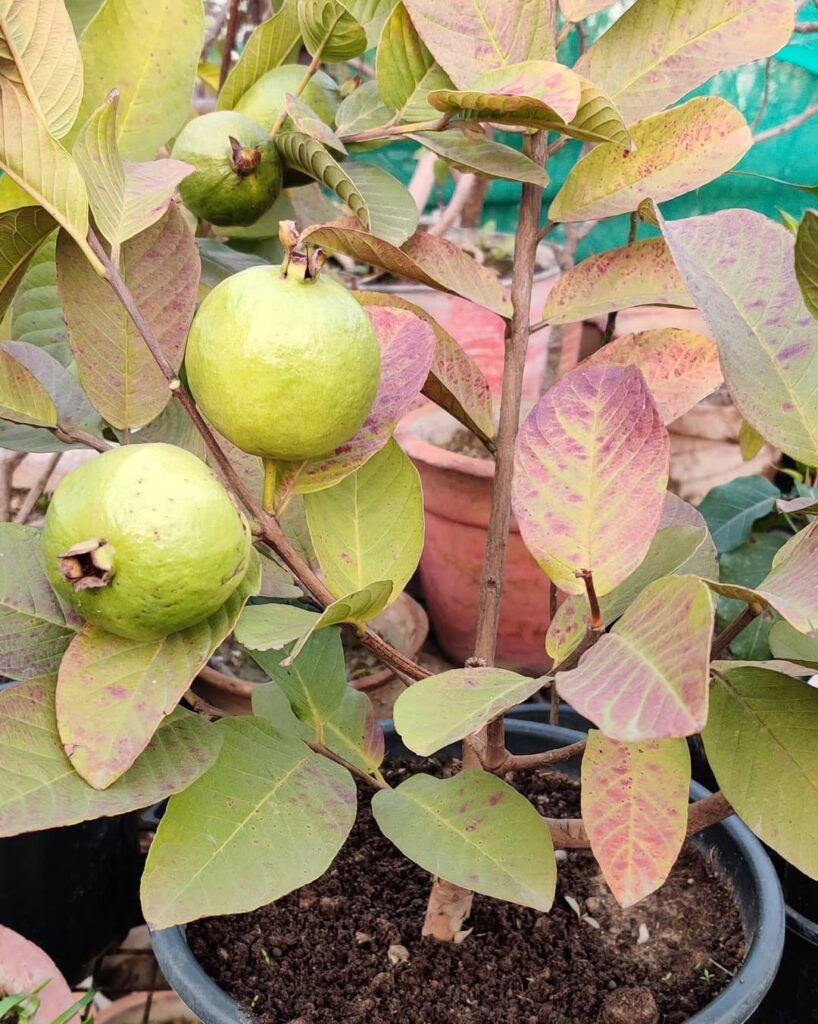
Growing guava trees indoors can be a rewarding experience, as these tropical fruits can thrive in containers when given the proper care. Indoor guava trees typically reach heights of 6-8 feet when container-grown, producing fragrant flowers and sweet, nutritious fruits. While they may take 2-4 years to begin fruiting, these evergreen plants make attractive houseplants with their glossy leaves and compact growing habit.
- Light: Bright, direct sunlight for 6-8 hours daily; place near south-facing window
- Temperature: 70-85°F (21-29°C); protect from cold drafts
- Humidity: High humidity (50% or higher); regular misting or humidity tray recommended
- Soil: Well-draining potting mix rich in organic matter; pH 6.0-7.0
- Water: Keep soil consistently moist but not waterlogged; water when top inch of soil feels dry
- Container: Large pot (15-20 gallons) with drainage holes
- Fertilizer: Monthly feeding with balanced, water-soluble fertilizer during growing season
- Pruning: Regular pruning to maintain size and shape; remove crossing branches
- Pollination: Self-pollinating, but hand-pollination may increase fruit set indoors
14. Mandarin Orange Tree

The Indoor Mandarin Orange Tree is a compact citrus variety that can thrive as a houseplant, typically reaching heights of 4-6 feet when grown indoors. These trees produce sweet, easy-to-peel fruits and feature glossy, dark green leaves with aromatic white blossoms that fill rooms with a sweet fragrance. While smaller than their outdoor counterparts, indoor mandarin trees can still produce a respectable harvest when properly maintained, making them an attractive and rewarding choice for indoor fruit cultivation.
- Light: Requires 6-8 hours of direct sunlight daily; best placed near a south-facing window
- Temperature: Maintains ideal growth at 65-75°F (18-24°C)
- Humidity: Prefers 50-60% humidity; may need regular misting or a humidity tray
- Soil: Well-draining citrus soil mix with pH between 6.0-7.0
- Water: Keep soil consistently moist but not waterlogged; water when top 1-2 inches feel dry
- Fertilizer: Feed with citrus-specific fertilizer every 6-8 weeks during growing season
- Container: Use a pot with adequate drainage holes, sized 2 inches larger than root ball
- Air Circulation: Benefits from good air flow but should be protected from cold drafts
15. Dwarf Apple Tree

Dwarf apple trees adapted for indoor growing are compact versions of standard apple trees, typically reaching heights of 3-6 feet when mature. These miniature varieties are grafted onto special rootstock that limits their size while still producing full-sized, edible fruit. Indoor dwarf apple trees require careful maintenance and specific conditions to thrive and produce fruit, making them an ambitious but rewarding choice for indoor gardeners.
- Light: Requires 6-8 hours of direct sunlight daily; place near south-facing window or provide supplemental grow lights
- Temperature: Maintains best growth at 65-75°F during day, with 10-15°F cooler at night
- Soil: Well-draining potting mix rich in organic matter, pH between 6.0-7.0
- Water: Keep soil consistently moist but not waterlogged; water when top 1-2 inches of soil feels dry
- Humidity: Moderate humidity levels around 40-50%
- Container: Large pot (15-20 gallons) with adequate drainage holes
- Pollination: Most varieties need a compatible pollinator tree or hand pollination
- Fertilizer: Apply balanced, slow-release fertilizer in spring and summer
- Pruning: Regular pruning to maintain size and shape, especially during dormancy
